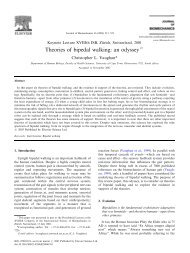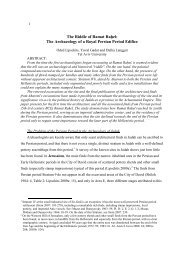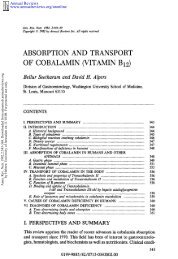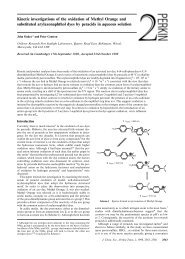The Cemetery of Azor and Early Iron Age Burial Practices
The Cemetery of Azor and Early Iron Age Burial Practices
The Cemetery of Azor and Early Iron Age Burial Practices
Create successful ePaper yourself
Turn your PDF publications into a flip-book with our unique Google optimized e-Paper software.
Ben-Shlomo<strong>The</strong> <strong>Cemetery</strong> <strong>of</strong> <strong>Azor</strong>Dothan 1982, 29–33, 260–68; Brug 1985, 149–64;Gonen 1992, 124–31; Gilmour 1995, 155–63), whichinclude rock-cut tombs with a dromos <strong>and</strong> benches.<strong>The</strong> most typical examples are the five large rock-cuttombs at Tell el-Farah(S), Tombs 542, 552, 562, 532<strong>and</strong> 544 (Petrie 1930, 6–9, pls XVII–XXII, LXIV;Dothan 1982, 30), that were considered to have beenused by single families for several generations. <strong>The</strong>yare lined in a row <strong>and</strong> are built <strong>of</strong> a stepped dromos, alarge hall with elevated benches <strong>and</strong> in two cases anadditional inner hall. <strong>The</strong> multiple burials includedsupine burials, many burial goods <strong>of</strong> Canaanite <strong>and</strong>Philistine pottery, small finds, <strong>and</strong> in two casesanthropoid c<strong>of</strong>fins. <strong>The</strong> ‘Philistine’ tomb at ‘Eitun(Edelstein <strong>and</strong> Aurant 1992) may also be similar.Note, however, that this type <strong>of</strong> tomb may also betraced to some extent in bi-lobate Late Bronze <strong>Age</strong>tombs <strong>of</strong> the southern Levant (Stiebing 1970). Thus,generally, the Philistine character <strong>of</strong> other <strong>Iron</strong> Iburials is not evident from distinct funerary practices,but rather, the relation to the Philistines is inferred,either from the geographic location (in Philistia), orfrom the Philistine vessels found in the graves, <strong>and</strong> is,thus, highly circumstantial.<strong>The</strong> social <strong>and</strong> cultural aspects <strong>of</strong> the burials at<strong>Azor</strong> can be examined according to the type <strong>of</strong> burial<strong>and</strong> the burial goods. <strong>The</strong> brick-case tombs are verypoor in burial goods, while some <strong>of</strong> the pit burials arericher, as well as the jar burials (Table 3; Fig. 20).Items buried with the deceased can reflect eitherpersonal items (such as clothes, jewellery), itemsshowing status (such as weapons) <strong>and</strong> items essentialfor ‘the well being <strong>of</strong> the spirit’ for the world beyond(see O’Shea 1984, 8–13; Baker 2006, 1). Both burials<strong>of</strong> children <strong>and</strong> females at <strong>Azor</strong> <strong>of</strong>ten include manyburial gifts, such as pottery <strong>and</strong> scarabs, as well aspersonal items, such as jewellery <strong>and</strong> beads (seeTable 2). Jewellery appears with children <strong>and</strong> adults,while the finds <strong>of</strong> various pin types suggests that thebodies were buried clothed. <strong>The</strong>re is not enoughinformation about scarabs, but they appear mostly inpit burials; scarabs are usually considered as amuleticobjects related to the well being <strong>of</strong> the spirit (Baker2006, 21). <strong>The</strong> burials in <strong>Burial</strong> Structure B (TombD79), reflecting a mixture in terms <strong>of</strong> age <strong>and</strong> gender<strong>of</strong> the deceased, contain all types <strong>of</strong> burial gifts.Weapons do not appear, with the exception <strong>of</strong> a bimetallicknife (Fig. 21:2), but this could be consideredas a tool too. <strong>The</strong>refore, no clear correlationbetween burial types <strong>and</strong> social status or rank <strong>of</strong> thedeceased can be identified. If social status rather thanethnic origin is to be inferred from the burial goodsrecovered, one may suggest that there were no greatsocio-economic differences between the buriedindividuals at <strong>Azor</strong>, as most classes <strong>of</strong> objectsappear in most types <strong>of</strong> burials. An exception couldbe Tomb D63 which contains a gold item (the mouthpiece).Philistine pottery, mainly bowls, kraters <strong>and</strong> closedvessels are included in all types <strong>of</strong> burials during the<strong>Iron</strong> I. Philistine jugs including ‘feeding bottles’appear; this form <strong>of</strong>ten appears in LHIIIC/<strong>Iron</strong> IAegean tombs as at Perati (Iakovidis 1969, pls 117,134, 138) <strong>and</strong> Cyprus (Steel 1995, 200). During the<strong>Iron</strong> IIA the pit burials <strong>and</strong> burial structures containmainly Cypro-Phoenician <strong>and</strong> other juglets. <strong>The</strong>Philistine pottery within the burials could be interpretedas reflecting the ethnic identity <strong>of</strong> the deceasedas Philistines, but, these vessels could have beenselected as burial goods on account <strong>of</strong> their elaborateappearance, similar to the imported Cypriote <strong>and</strong>Mycenaean vessels during the LBII <strong>and</strong> the Cypro-Phoenician/Black on Red vessels during the <strong>Iron</strong> IIA(Bloch-Smith 1992a, 79). According to petrographythe Philistine, as well as the non-Philistine, vesselswere locally produced <strong>and</strong> possibly local workshopsalready specialized in producing Philistine vessels, orPhilistine-imitations, to cope with the large dem<strong>and</strong><strong>of</strong> burial goods at <strong>Azor</strong>. <strong>The</strong>refore, at this stage, theappearance <strong>of</strong> Philistine Bichrome vessels in burialsat the southern Levant cannot be considered as anindicator for a Philistine ‘ethnic’ identity <strong>of</strong> theindividuals in these burials. While distinct Aegean orPhilistine burial customs are difficult to identify inthis stage, some <strong>of</strong> the material culture from the <strong>Iron</strong>I graves at <strong>Azor</strong> has certain Philistine components;whether Philistine people were indeed buried in some<strong>of</strong> these graves is still difficult to determine. <strong>The</strong>anthropological evidence quoted from <strong>Azor</strong>, relatingto the many ‘brachicephalic’ type skulls from thegraves (especially from the brick-case tombs), whichallegedly represent foreign individuals (Dothan <strong>and</strong>Dothan 1992, 115–17), should be taken with extremereservation, as most <strong>of</strong> these skulls were notexamined after the preliminary inspection, <strong>and</strong> theethnic significance <strong>of</strong> skull geometric characteristicsis also questionable (Y. Nagar, pers. comm.).Moreover, decorated, as well as non-decorated,pottery vessels from graves were possibly importantbecause <strong>of</strong> their content, which was related to certainfunerary rituals (e.g., Pitard 2002, 149). Bloch-Smithdistinguished between burial customs or ‘kits’ <strong>of</strong> thelowl<strong>and</strong>s <strong>and</strong> highl<strong>and</strong>s in <strong>Iron</strong> <strong>Age</strong> Palestine (1992a,143, table 9; Bloch-Smith 2002, 120–21, 124–25);such st<strong>and</strong>ard burial kits could represent the burialceremony rather than the status or rank <strong>of</strong> the50 Levant 2008 VOL 40 NO 1







